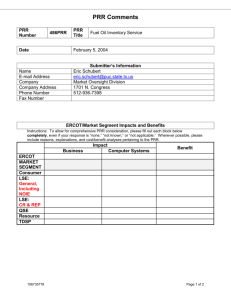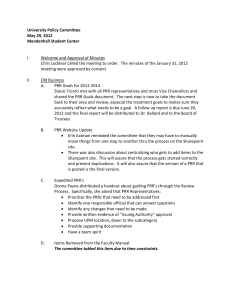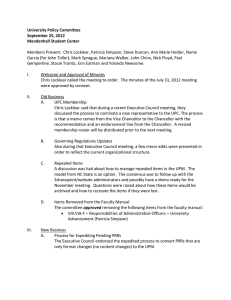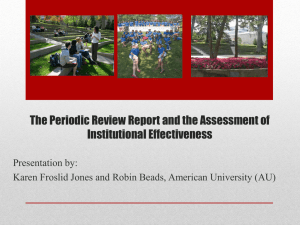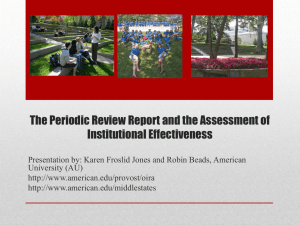Proportional Rate Reduction
advertisement
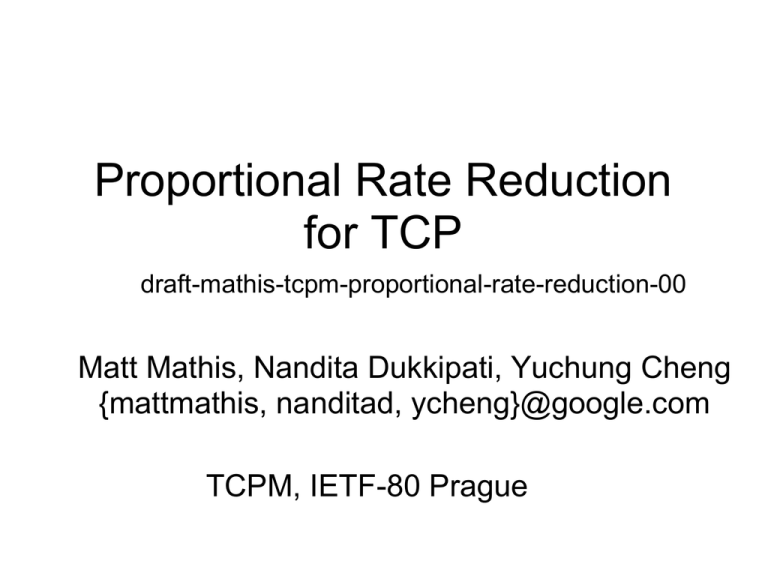
Proportional Rate Reduction
for TCP
draft-mathis-tcpm-proportional-rate-reduction-00
Matt Mathis, Nandita Dukkipati, Yuchung Cheng
{mattmathis, nanditad, ycheng}@google.com
TCPM, IETF-80 Prague
Motivation
Two widely deployed algorithms in loss recovery: RFC 3517
fast recovery and Rate halving.
There are cases when both are prone to timeouts.
RFC 3517 fast recovery waits for half of ACKs to pass
before sending data.
Rate halving does not compensate for implicit cwnd
reduction under large losses.
Goals of Proportional Rate Reduction.
Reduce timeouts by avoiding excessive window
reductions.
Converge to cwnd chosen by congestion control by the
end of recovery.
Proportional Rate Reduction with
Reduction Bound (PRR-RB)
PRR-RB has two algorithms.
Proportional rate reduction (PRR):
Patterned after rate halving but with a factor that
depends on congestion control reduction.
Main idea: sending rate = r * queue drain rate in
recovery; r is CC reduction factor.
For precision, queue drain rate is computed as amount
of newly delivered data to receiver.
Reduction bound (RB):
Main purpose: inhibit further cwnd reductions under large
losses (pipe < ssthresh).
PRR-RB pseudo code
Start of recovery:
ssthresh = CongCtrlAlg() // Target cwnd after recovery.
RecoverFS = snd.nxt - snd.una // FlightSize at start of recovery.
On each ACK in recovery, compute:
// DeliveredData: #pkts newly delivered to receiver.
DeliveredData = delta(snd.una) + delta(SACKd)
// Total pkts delivered in recovery.
prr_delivered += DeliveredData
pipe = RFC 3517 pipe algorithm
Algorithm:
if (pipe > ssthresh) // Proportional Rate Reduction.
sndcnt = CEIL(prr_delivered * ssthresh / RecoverFS) - prr_out
else
// Reduction Bound.
sndcnt = MIN(ssthresh - pipe, prr_delivered - prr_out)
On any data transmission or retransmission:
prr_out += (data sent) // Smaller than or equal to sndcnt.
Properties of PRR-RB
Spreads out window reduction evenly across the
recovery period.
Converges to target cwnd chosen by CC for minimal losses.
Maintains ACK clocking even for large burst losses.
Precision of PRR-RB is derived from computing
exact segments delivered to the receiver during recovery.
On every ACK, cumulative data sent during recovery is
bound by the cumulative data delivered to the receiver
during recovery.
Banks the missed opportunities to send if application stalls
during recovery.
Less sensitive to errors of the pipe estimator.
Proportional Rate Reduction without
Reduction Bound (PRR w/o RB)
Observation: there are cases where RFC 3517 sends more
than the reduction bound of PRR-RB.
Example: pipe == cwnd == 100 packets, lost packets 1 90, packet 93 can generate a burst up to 40 packets.
RFC 3517 is not conservative in this scenario.
PRR-RB bounds #pkts sent by (prr_delivered prr_out).
PRR w/o RB: cwnd is bound below only by ssthresh.
if (pipe > ssthresh) // Proportional Rate Reduction
sndcnt = CEIL(prr_delivered * ssthresh / RecoverFS) - prr_out
else
sndcnt = ssthresh - pipe
Example flow in PRR-RB, PRR w/o RB
Different from PRR-RB
only for large burst losses
(not shown here).
pkts sent ==
pkts delivered.
pipe == ssthresh
Ratio of pkts sent to
delivered is 0.7.
Ratio of pkts sent to delivered is
0.7.
Example flow in Linux and RFC 3517
cwnd == pipe + 1
Ratehalving: send one
new pkt on
alternate ACKs.
Linux flows often end up in slow start after
recovery when short responses have no
new data to send and pipe reduces to 0 .
Silent period
at start of recovery.
Other
recovery
events.
Performance
Two kinds of experiments: Google Web server, datacenter traffic.
PRR w/o RB reduces timeouts in recovery.
Reduces tail latency of 1MB RPCs by 35% (w.r.t. RFC) and
16% (w.r.t Linux).
PRR w/o RB
RFC 3517
Linux
FastRecovery events
1,759
2,755
1,738
TotRetrans
8,471
15,236
8,282
FastRetrans
RegularFastRetrans
ForwardFastRetrans
8371
7,916
455
14881
13,202
1,679
8158
7,971
187
TimeoutRetrans
TimeoutOnOpen
TimeoutOnRecovery
TimeoutOnDisorder
41
7
18
16
177
17
148
12
50
16
20
14
99% latency of 1MB
RPCs (us)
15,064
23,105
17,956
Data in this spreadsheet: http://goo.gl/xl6cF
Benefits and costs
Benefits:
Smaller number of timeouts.
In some cases, smaller number of recovery events.
Lower tail latencies of request-response traffic.
Cost:
Need to investigate if there are indirect costs to sending
packets early on in recovery as opposed to letting more
ACKs pass first.
Going forward
Should the PRR draft be a WG item?
Design of PRR improves upon the current standard in
reducing timeouts.
Initial experiments demonstrate promising results.
Goal: adopt as experimental so people can gain
experience.
